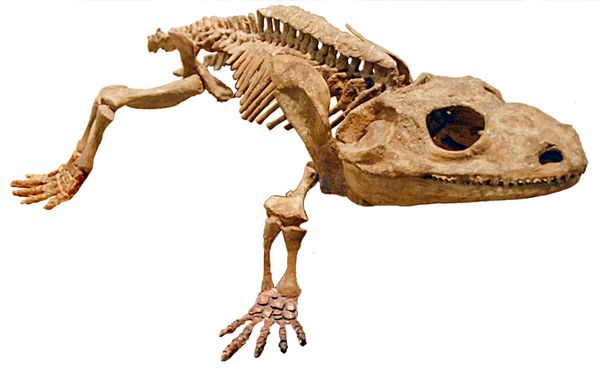Athena Review Image Archive ™
Cacops aspideformus

Cacops aspideforums (Field Mus.Nat.Hist.)
Cacops aspideformus was a temnospondyl, a group of amphibians ancestral to synapsid reptiles, and thus ancestral to mammals. Dating from the Early Permian period in the Kungurian phase (290-280 mya), Cacops aspideformus was first discovered in the Permian Basin of north Texas by Samuel Williston in 1910. It is in the class Amphibia, the order Temnospondyl, and the family Dissorophidae. A second species, Cacops morrisi, was discovered in Oklahoma by Reisz et al. (2009).
The body length of Cacops was 40 cm (16 in). Its right forelimb, shown in this image, has a humerus, radius, ulna, and five digits, all of which represent a primitive tetrapod state. Cacops was well adapted to a terrestrial lifestyle, with a heavily built skull, strong legs, a short tail, and a row of armor plates along its back.
Cacops is derived from a sister to Amphibamus and represented the last of this lineage, other than perhaps Platyhystrix. The skull of Cacops, however, was larger overall and distinct from that of Amphibamus. Cacops' skull was deeply pitted, taller and narrower, making up a third of the entire body length. The eye orbit was raised and the otic notch was completely encircled. Compared to other species in the dissorophid family, Cacops has an enormous otic notch in the back of the skull enclosed with a bony bar, indicating a large eardrum.
References:
Reisz, R.R., Schoch, R.R., and Anderson, J.S. 2009. The armoured dissorophid Cacops from the Early Permian of Oklahoma and the exploitation of the terrestrial realm by amphibians. Naturwissenschaften 96 (7).
Williston S.W. 1910. Cacops, Desmospondylus: new genera of Permian vertebrates. Bull. Geol. Soc. Amer. XXI 249-284, pls. vi-xvii.
Copyright © 1996-2020 Rust Family Foundation (All Rights Reserved).